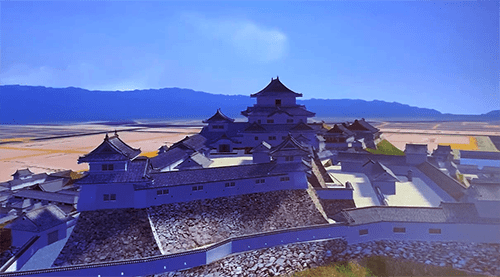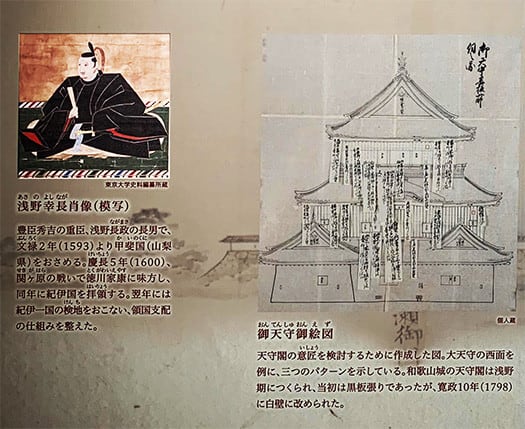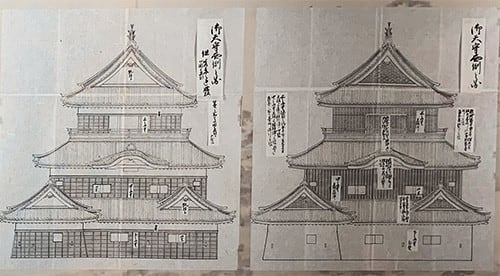



城郭というのは戦国末期から江戸時代に非常に多く建築された。
地形のそれぞれの特徴を把握したり、軍事的な側面からの立地選択など、
いかにも「用」としての基本設計部分については
当時の軍事常識を踏まえた合理的な分析が可能だと思います。
そういうなかで「天主」という建築は、
目的としては高所からの情勢判断、観望ということだろう。
この段階での戦争は基本的には白兵戦による陣地攻防戦。
軍勢の動きを高所から観望して各陣地に戦力配置する判断にとって
必要欠くべからざる建築要素だったことでしょう。
一方で地域支配の象徴であり、ある意味安心感の担保装置。
武力という目に見える権力の象徴、アイコンになっていた。
天主という建築領域がいつ成立したのかは不勉強ですが、
一般的には戦国の覇者・信長が築いた安土城天守がその嚆矢だったと思える。
独特の「天下布武」思想を実践していった信長らしい建築として
近年、その復元が行われた博物館も安土にはあり、見学して
その様子をこのブログでも紹介しています。
いかにも「天主」というコトバ通りの上層階デザインが展開していた。
天主というものの基本属性から「どう見られるか」ということに
権力者として強く意識を持つに違いない。
権力者は古今東西、自分が権力者であることを他者に強く認識させたい。
一方で自然人としてはなぜ自分が他者よりも上位なのか、
不安にさいなまれるのが普通の感覚なのでしょう。
そういう不安心理は建築という人間行為に深く反映していく。
和歌山城で「外観デザイン検討図案」を興味深くみた。
豊臣支配が関ヶ原で転換し、1600年に紀州を領国とした浅野氏が
その権力を誇示するために「見え」について考えた痕跡。
2枚目の写真と3枚目の写真の3点の外装デザインを巡って
領主・浅野氏と家臣団、建築担当者スタッフとの打合せ記録です。
武士という階層は戦国末期に至って支配層として身分を確立させた。
日本的な「封建権力」として固定化された。
そうすると様式化が急速に進んでいったのだと思える。
その大きな精神性テーマが「見え」だった。
一昨日触れた「三十三間堂通し矢」などの様式化されたことがらに対して
自らの記録を破られたことを「恥辱」と感じる感性。
そのようなバカげたことに「一所懸命」になるように追い詰められる心性。
総じて「見え」にこだわって生きるという悲しい不安の心理。
天主のデザインにこだわる心性には同様の要因が隠されているように思う。
しかし歴史を踏まえた日本人のDNAにはこういう心理要素が色濃いのも事実。
そして明治から150年、世界大戦から75年という節目を越えてきて、
現代建築も新しい価値感に変移していく時期かも知れない。
English version⬇
The study drawing of the castle tower design - Exploration of Nara and Wakayama - 32
The image of the samurai of the peaceful period, who placed the utmost importance on "visibility". The architects wanted to solve their own anxiety through architecture, and were obsessed with the "visual symbol of domination. .......
Castles were built in great numbers from the end of the Warring States period to the Edo period.
The basic design of castles was based on an understanding of the characteristics of the terrain and the choice of location from a military standpoint.
The basic design of a castle is based on the common sense of the military at that time.
I think it is possible to make a rational analysis based on the military common sense of the time.
In this context, the architecture of the "Tenshu" was designed for the purpose of
The purpose of the "Tenshu" architecture was to assess and observe the situation from a high place.
The war at this stage was basically a battle between white soldiers and the enemy.
The "tenshukaku" is an indispensable architectural element to observe the movement of the army from a high place and to make decisions on the allocation of forces to each position.
The building was an indispensable architectural element for observing the movement of the army from a high vantage point and making decisions on how to deploy forces in each position.
On the other hand, it was a symbol of regional control and in a sense a security device.
It was a visible symbol of power and an icon of military might.
I am not sure when the architectural domain of "tenshu" was established, but it is generally believed to have been a symbol of the supremacy of the Warring States period.
Generally speaking, it seems that the Azuchi Castle keep built by Nobunaga, the supreme ruler of the Warring States period, was a pioneer in this field.
The castle was built by Nobunaga, the supreme ruler of the Warring States period, and it is believed to have been a pioneer in the field of architecture.
In recent years, there is a museum in Azuchi where the castle was restored.
I have already introduced it in this blog.
The design of the upper floors was exactly as the word "tenshu" (Lord of Heaven) implies.
The basic attribute of the "Lord of Heaven" is that it is strongly conscious of "how it is seen" as a person in power.
The person in power must be very conscious of how he or she is seen.
Those in power, in all ages and cultures, want others to strongly perceive them as being in power.
On the other hand, as a natural human being, it is normal to feel insecure about why you are higher than others.
It is normal for a natural person to feel anxious about why he or she is superior to others.
This kind of anxiety is deeply reflected in the human act of architecture.
At Wakayama Castle, I looked at the "Exterior Design Study Plan" with great interest.
The Asano clan, which took over Kishu in 1600 after Toyotomi's rule changed after the Sekigahara War, built the castle in 1600.
The second and third pictures show the traces of the Asano clan's consideration of "visibility" in order to show off their power.
The three exterior designs in the second and third photos
These are records of meetings between the lord Asano, his retainers, and the staff in charge of construction.
The warrior class established its status as the ruling class toward the end of the Warring States period.
It was fixed as a Japanese-style "feudal power.
It would seem that stylization then proceeded rapidly.
The major spiritual theme was "visibility.
In response to the stylized events such as the "Sanjusangendo through arrow," which I mentioned the day before yesterday, the Japanese people were ashamed and humiliated that their own records had been broken.
The sensitivity to feel "humiliation" at having one's own record broken.
The mentality of being driven to "work hard" at such a silly thing.
A sad and anxious mindset of living in general, obsessed with "visibility.
I think the same factor is hidden in the mentality that is obsessed with the design of the tenshukaku.
However, it is also true that these psychological elements are strong in the DNA of the Japanese people based on their history.
And now that we have passed the milestone of 150 years since the Meiji Era and 75 years since the end of World War II, modern architecture is also shifting to a new sense of values.
It may be time for modern architecture to shift to a new sense of values.



















